This page shows floor plans of ~100 most common HDB flat types and most representative layouts. Many other layouts exists, unique layouts with slanted rooms, as well as variations of the standard layouts, these usually have larger sizes.
Most searched floor plans: 1960s 3STD 3I 4I, 1970s 3NG 4NG 5I, 1980s 3S 3A 4S 4A 5A, 1990s 4A 5I, EA, 2000s 4A 5I EA, Maisonette, Jumbo, Pinnacle
FAQ: age of HDB block? What is lease commence date? How I got floorplans? Looking for .DWG floor plans?
Do you want to see floor plans from a particular block address? Look for it on Interactive map of HDB blocks.
1930s, 1940s, 1950s – SIT era
Singapore Improvement Trust set up in 1927 and focused on infrastructure, it also built small scale public housing, such as Tiong Bahru (started in 1936) and Queenstown (started in 1952 and completed by HDB in 1960s). In 32 years, SIT built only 23,000 flats, housing 8.8% of Singapore population in 1959.
The SIT housing was similar with British housing, 2-storey terraced houses, 3/4-storey walk-up flats, 7/9-storey high-rise flats started being built in 1952 and one 14-storey block was built in 1956 in Queenstown. The blocks were built at just 10-15 meters apart, denser than HDB estates. List of SIT estates.
Tiong Bahru pre-war vs post-war SIT blocks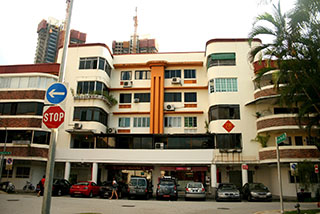
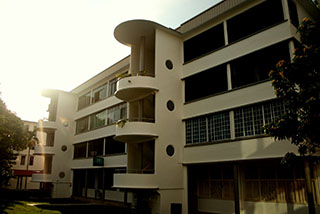
SIT floor plans
Pre-war Tiong Bahru blocks feature flats from 3-room to 5-room, you can see floor plans on tiongbahruestate.wordpress.com > tiong-bahru-pre-war-floor-plans and tiongbahruestate.wordpress.com > uncategorized.
Post-war, SIT built mostly 2-room and 3-room, a small number of 4-Room flats were built at least in Alexandra North, Silat Estate and Tiong Bahru, but I never found any floor plan. To speed up construction, flats were downsized in 1955 and fewer 4-room were built. 1-Room flats on double-loaded corridor were introduced in 1958 in Kallang Airport Estate. For people displaced by fires SIT built also tenements (blocks with communal kitchen and toilets, opposite of “self-contained flats”).
SIT blocks with 2-Room / 3-Room Standard flat, from Tiong Bahru and Redhill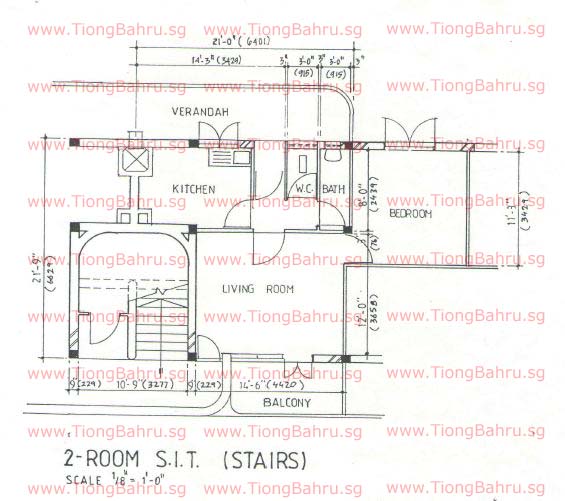
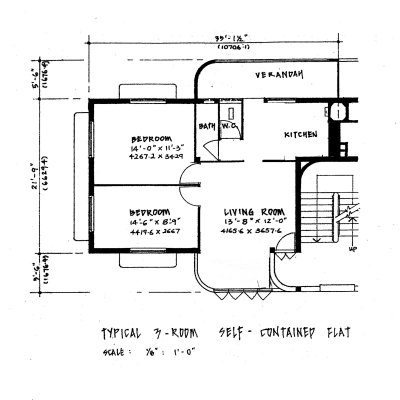

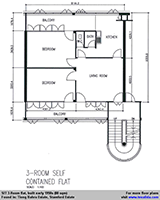
SIT also built terraced houses, two clusters survived: Jalan Bahagia (in Whampoa, 28 blocks, 200 units), Stirling Road (in Queenstown, 13 blocks, 84 units). Most units are 3-Room (originally 78 sqm) but 4-Room (99 sqm) do exist at Stirling Road. Over time, the owners built additional rooms in front, rear, and side of corner units, some houses now exceed 200 sqm according resale transactions.
Some floor plans of rental flats are available on HDB InfoWEB under PPHS (whole block floor plans, no dimensions).
1960s – HDB beginnings
HDB was founded in February 1960, shortly after People Action Party won national elections of 1959. HDB continued construction of some SIT estates: Queenstown, Kallang Airport, St. Michael, Kampong Tiong Bahru, and launched new estates like Bukit Ho Swee, Brickworks, Alexandra Hill, Redhill, Henderson (in Bukit Merah); Bendemeer, Boon Keng, Kallang Bahru and Tanjong Rhu (in Kallang), Upper Changi Road aka Chai Chee (now part of Bedok), MacPherson (in Geylang), MacPherson Homes (in Toa Payoh).
On 13 February 1959 a fire started in Kampong Tiong Bahru, leaving 12,000 people homeless (source: NLB). SIT quickly cleared the area and built few 5-storey blocks with 1-Room flats and 9-storey blocks as well as terraced houses. Most famous fire is Bukit Ho Swee fire on 25 May 1961 that left 16,000 people homeless, as coincidence HDB completed in September 1961 the Kampong Tiong Bahru flats started by SIT and fire victims were relocated in them, after being houses temporarily in Queenstown for few months. These fires helped HDB to gain popularity.
In Master Plan 1958 you can see numerous terraced houses (planned by SIT and never built) around Redhill and Whampoa. HDB aimed to build 50,000 dwelling units in first 5 years, so a simple brutalist architecture was chosen, in contrast with the Art Deco and Modernist themes used by SIT.
Queenstown was de facto first new town (built outside city), but Toa Payoh New Town started in 1965 was the first officially named “New Town”), incorporating a town centre and several neighborhoods. Toa Payoh preliminary plan was published in SIT Annual Report 1958, including terraced houses and low-rise blocks of flats. Farmers that opposed government taking their land delayed construction for few years, enough for HDB to change plans to high rise blocks with smaller flats than SIT blocks.
The first blocks completed by HDB are Queenstown blk 45, 46, 49, 7-storey blocks styled like SIT.
Redevelopment of uneconomical SIT estates started in 1967, single-storey artisans quarters built by SIT in 1951-1953 at Henderson and Upper Aljunied were demolished and replaced by high-rise blocks.
1960s estates composed only by linear slab blocks (corridor style) in most common height of 10 storeys and usually with 12 units per floor, but several blocks were longer, plus 2-storey shophouses. Minimal distance between facades was not regulated, usually 15-30 metres.
Old photos from Bukit Ho Swee estate (built 1961-1964)
The 7-storey blocks in left side had 1-Room Emergency flats.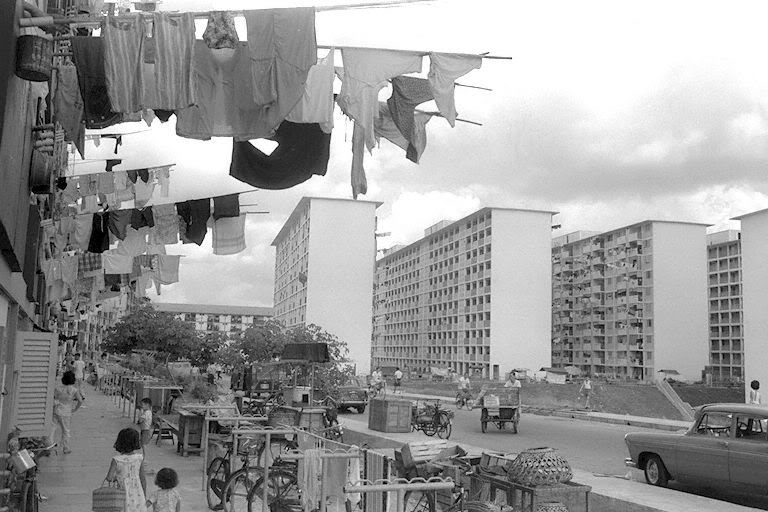
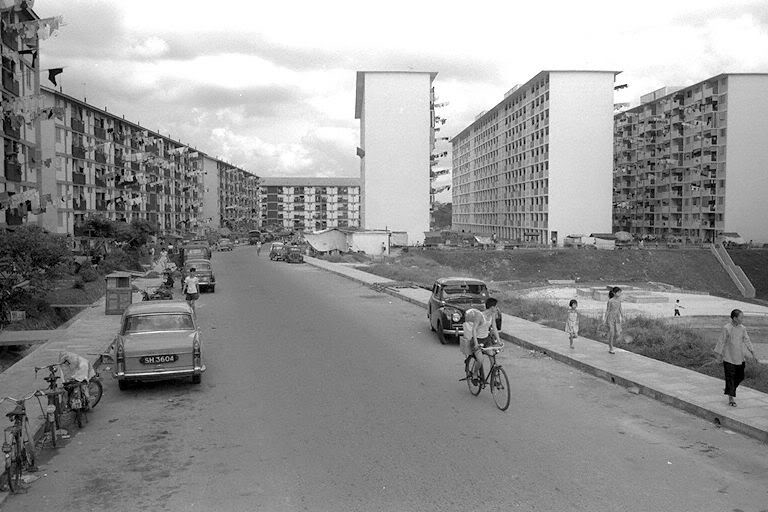
Old aerial views of Redhill estate (built in 1960s)
Many 5-storey blocks with 1-Room Emergency flats (demolished during 1980s) and 10-storey blocks with 2/3-room flats (some surviving).
Old aerial views of Toa Payoh New Town (first phase built 1966-1973)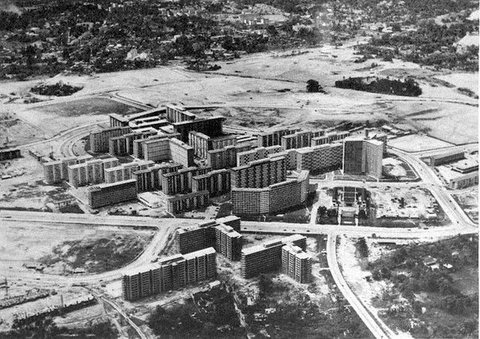
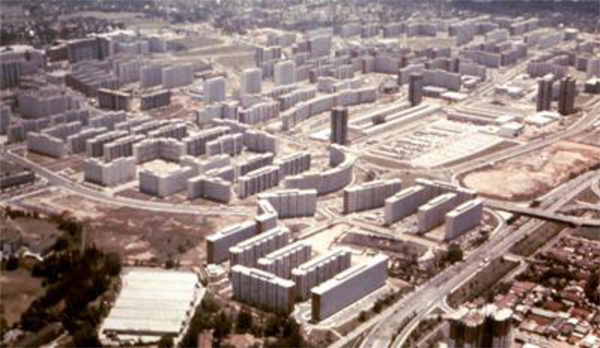
1960s typical HDB floor plans
In first 5 years HDB built flats in proportion of 40% 1-room, 30% 2-Room, 30% 3-Room. The floor areas have broad range: 1-Room (23-33 sqm), 2-Room (35-45 sqm), 3-Room (50-70 sqm). 4-Room were introduced in 1967 at Henderson Road. Later in Outram Park and Toa Payoh (70-85 sqm). I estimate average size during 1960s around 40-50 sqm.
Standard flats (1/2/3/4-room) had WC and shower in same room.
Improved flats (1/2/3/4-room) were introduced in 1966, the 3/4-room having separate WC and shower, they also featured void decks.
Emergency flats (1/2-room on double-loaded corridor) were also built. I do not know how many emergency blocks were built, because only 5 blocks survived: blk 91, 92, 93 Henderson Rd , blk 1 Maude Rd, blk 2 Kitchener Rd (2-room, all rental). The typology with double-loaded corridor was used also for 1-Room Improved.
Tenements (flats with communal kitchen and toilet, opposite of self-contained flats), were also built, for example Bukit Ho Swee blocks 1, 3, 5, 7, 9, according iremember.sg blog (I do not know if these were only tenement blocks or more been built).
1960-1970 slab blocks with 2-Room Standard (44-45 sqm), 3-Room Standard (50-55 sqm), 4-Room Standard (70-75 sqm)
Most blocks of this type were upgraded with utility rooms, some with bedroom extension including en-suite toilet.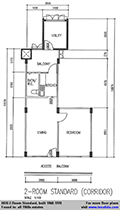
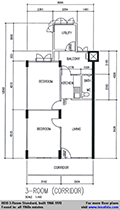
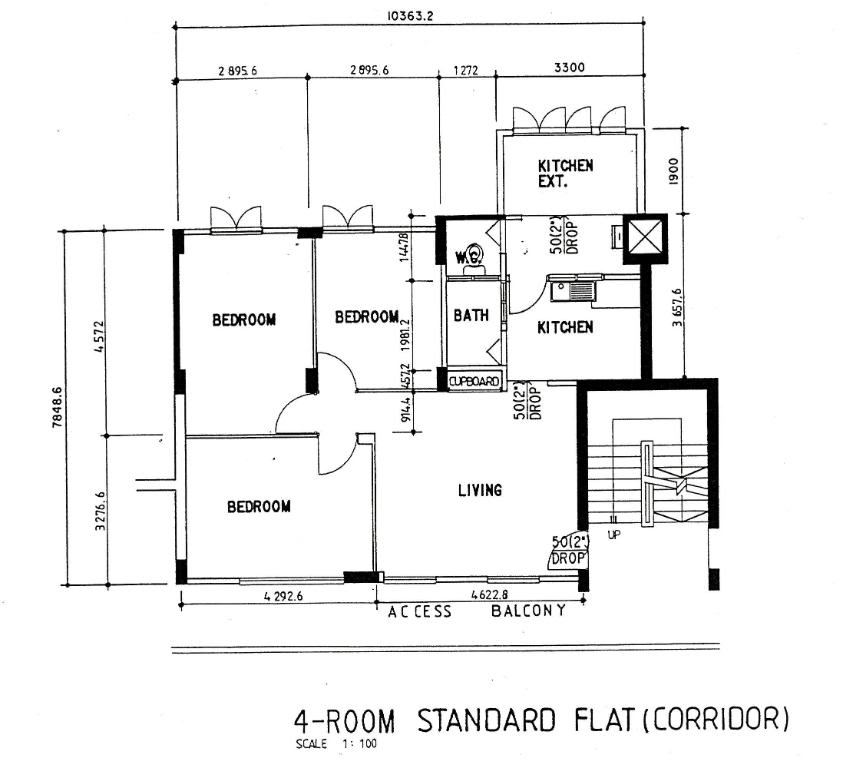
1966-1980 slab block with 1-Room Improved (33 sqm)
The ONLY remaining 1-room home ownership block is blk 7 Telok Blangah Crescent, two more blocks did existed but got SERS: blk 309 Ang Mo Kio Avenue 1 and blk 33 Taman Ho Swee. All other 1-room blocks are rental. Some of them are 2 meters wider, flats 6096 mm long instead of 5486 mm, toilet is squarish and kitchen is L-shaped around toilet, having 2 windows (example blk 123 Bukit Merah View). No floor plans available, because HDB never provide floorplans for rental flats.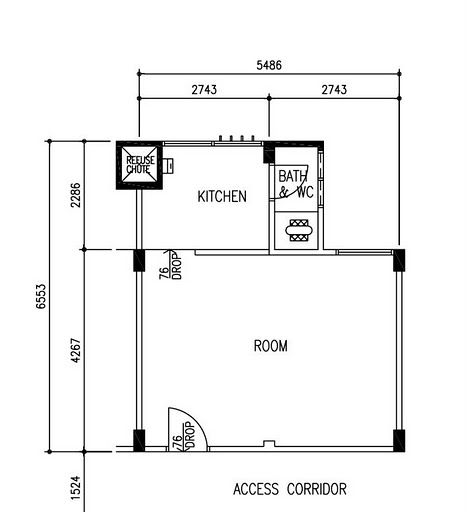
1966-1980 slab block with 2-Room Improved (44 sqm), 3-Room Improved (60 sqm), 3½-Room Improved (69 sqm)
A small number of 3I blocks were built in 1982-1986 with slightly different floor plan
Most blocks of this type were upgraded with 5-6 sqm utility rooms, these utility rooms vary in shape and size so that is why I posted here original floorplans without utility room.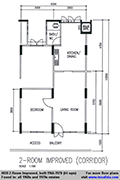 >
>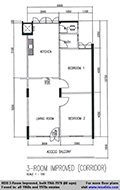
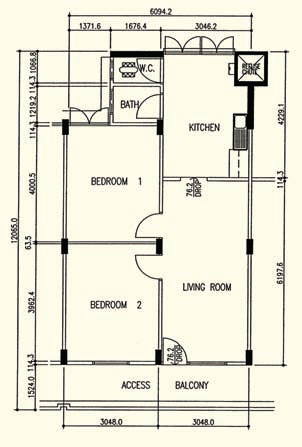
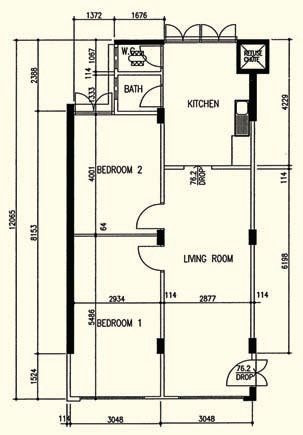
1972-1980 slab block with 4-Room Improved (82-84 sqm or -88 sqm with kitchen extension), stairs for each two units.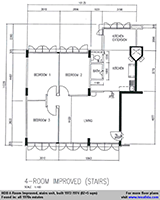
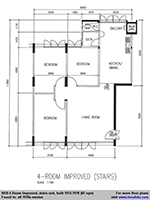
1970s – HDB new towns
Concept Plan 1971 featured a ring of New Towns around Central Water Catchment and a provisional plan for two MRT lines to be built by 1992.
In 1970s seven new towns were started: Ang Mo Kio 1975, Bedok 1975, Clementi / West Coast 1977, Hougang 1974 (only several blocks), Marine Parade 1974, Telok Blangah 1973, Woodlands 1973 (Marsiling estate). Toa Payoh was extended (blocks 210-235).
In addition, small estates were started: Kallang Basin (1960s?) and St. George 1975 (in Kallang); Geylang East 1974, Haig Road 1975, Jalan Eunos 1976, Sims 1974 (in Geylang); Dover 1975, Ghim Moh 1975, Holland Village 1973 (in Queenstown); Farrer Road 1973 (in Bukit Timah), Hillview 1977 (in Bukit Batok, demolished in 2005), Teck Whye 1977 (now part of Choa Chu Kang), Lorong Lew Lian 1977 (in Serangoon), Sin Ming 1973 (in Bishan), Nee Son 1977 (now part of Yishun).
1970s generation estates were dominated by massive slab blocks, majority 10-16 storeys and usually with 14 or 18 units per floor, most were over 100 metres long, plus point blocks, majority 25 storeys, and 4-storey blocks with shophouses. Minimal distance between facades was 30 metres.
HDB also built Rural Centres, mini estates with <4-storey blocks and several hundred flats to house farmers: Changi Village (considered in Pasir Ris), Kranji / Lim Chu Kang (abandoned in 2001), Punggol Road End (in Sengkang area, demolished in 2005-2007), Seletar Road (in Serangoon area, demolished 2005), Seletar West Farmway (in Sengkang area, demolished 2004).
Clementi (built 1977-1984) / Telok Blangah (built 1973-1978), view from Mount Faber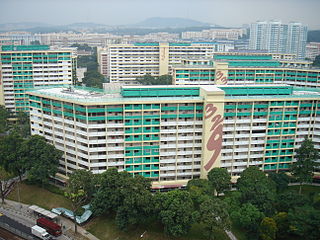
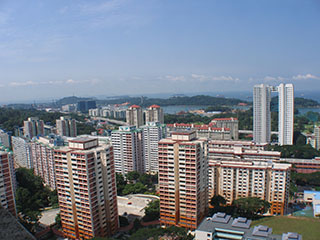
Marine Parade point blocks (built 1974-1976)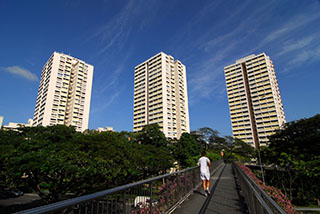
1970s typical HDB floor plans
In 1975 were completed the first New Generation flats: 3-Room (67 / 82 sqm) and 4-Room (92 sqm). Compared with Improved flats, the NG flats feature en-suite toilet for master bedroom, with pedestal type WC, plus store room (source: Straits Times 29 Aug 1973). This article HDB Floor Plans 1930-present is copyrighted by www.teoalida.com.
Point blocks, taller than surrounding blocks and having only 4 units per floor, the first had 3-Room flats, 2 were built in 1970 on Mei Ling Street and 2 in 1971 on Bendemeer Road, followed by 4-Room Improved (84 sqm) point blocks in 1973 and 5-Room Standard point blocks in 1974.
First 5-room flats (117-125 sqm), Standard and Improved were completed in 1974, in point block form. Starting from 1976, 5-Room flats were offered also in slab block form. All 5-Room flats feature master bedroom with attached toilet with pedestal type WC.
By mid-1980s 2 with 3-Room, 26 with 4-Room and 239 with 5-room. Blocks with 4 units per floor continued to be built in late 1980s, but height similar with surrounding blocks made me to not include them in above figure.
3/4-Room Standard flats disappeared in early 1970s, Improved flats disappeared too in late 1970s. The average size rose from 60 sqm in early 1970 to 75 sqm in late 1970s estates.
Marine Parade was, and is still the most prestigious HDB estate, also the oldest HDB estate remained intact (no demolitions, no new blocks). Built in 1974-1976, it contains 7898 dwelling units in 56 blocks, slab blocks with 2/3/4-Room Improved flats plus 17 tower blocks, each with 96 units of 120 sqm 5-Room Standard flats. Average flat size: 76 sqm, a record for its time (today average size is a little bigger due to upgrading with utility rooms and many 3-room flats adjoined.
1975-1986 slab block with 3-Room New Generation (67 sqm), 3½-Room New Generation (82 sqm), and 4-Room New Generation (92 sqm), big kitchen
1975-1985 slab block with 4-Room New Generation (91 sqm), two units per staircase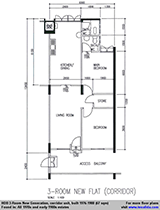
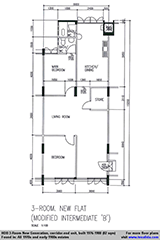
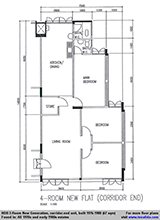
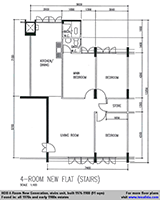
1976-1980 slab block with 5-Room Standard (117 sqm), also 4-Room New Generation (89 sqm) at lift level
1978-1985 slab block with 5-Room Improved (121 sqm), also 4-Room New Generation (98 sqm) at lift level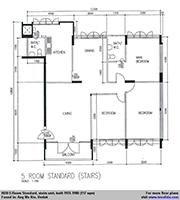
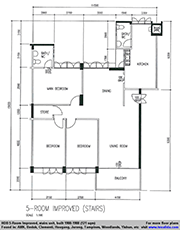
1970-1971 point zig-zag block with 3-Room Improved (72 sqm or 76 sqm with utility extension)
1973-1974 point block with 4-Room Improved (77-84 sqm)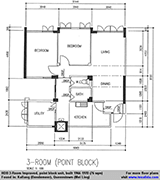
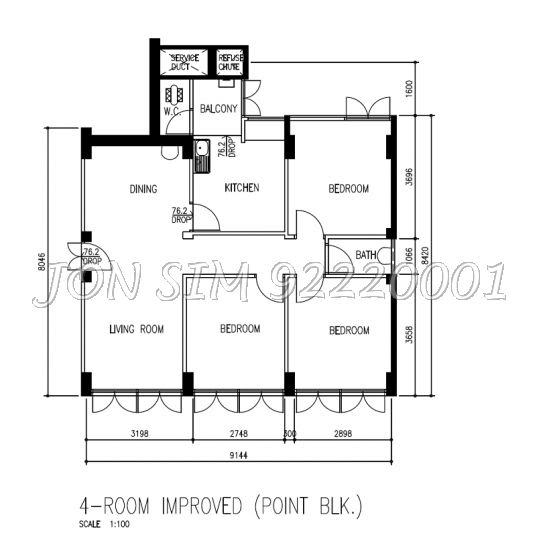
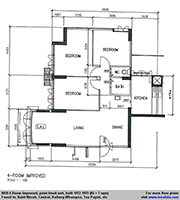
1974-1980 point block with 5-Room Standard (114-123 sqm)
1974-1985 point block with 5-Room Improved (117-121 sqm)
Some Standard flats have long master bedroom like Improved flats. Other flats have balcony at living room. I don’t know the real difference between Standard and Improved.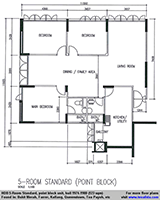
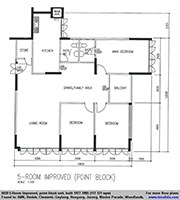
See more 1970s HDB floor plans, also JTC floor plans
1980s – More HDB new towns
In early 1980s nine New Towns were born: Bishan 1984, Bukit Batok 1982, Hougang 1980, Jurong East 1980, Jurong West 1981, Serangoon 1983, Tampines 1981, Woodlands 1980 (integrating Marsiling estate), Yishun 1981 (integrating Nee Son), as well as small estates: Kaki Bukit 1985 (in Bedok), Bukit Purmei 1982 (in Bukit Merah), Ubi 1984 (in Geylang), McNair 1982 (in Kallang), Potong Pasir 1983 and Upper Aljunied 1982 (in Toa Payoh).
In the late 1980 four more New Towns were born: Bukit Panjang 1986, Choa Chu Kang 1987 (integrating Teck Whye), Nanyang 1986 (extension of Jurong West), Pasir Ris 1987, as well as Estates: Simei 1987 (near Tampines), Kembangan 1988 (in Bedok), Toh Yi 1987 (in Bukit Timah).
1980s towns were composed by slab blocks with 10-13 floors, usually with 10 or 12 units per floor, plus point blocks with 20-25 floors, but also many 4-storey blocks. After 1985 just few blocks were built with more than 13 storeys. Compared with previous decade, the blocks were arranged in more rigid patterns, with corners bend to give the precinct a sense of enclosure. Most 10-13 floors blocks were perfectly aligned to east-west direction to avoid sun, surrounded on east and west sides by 4-storey walk-up blocks. Minimal distance between facades was 24 metres.
Ground floor units were reintroduced, most 1980s high-rise blocks have few (usually 4) units at ground floor while rest of floor is void deck. Most 4-storey blocks do not have void decks.
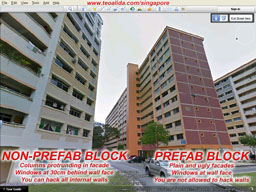 In 1980 first prefabrication contract was awarded, raising the construction ratio to about 190,000 flats built in 1981-1985, the record being 67,856 flats in 1984. Prefab blocks were built in 16 months, 20% faster than 20 months for normal blocks (source: Straits Times 1982).
In 1980 first prefabrication contract was awarded, raising the construction ratio to about 190,000 flats built in 1981-1985, the record being 67,856 flats in 1984. Prefab blocks were built in 16 months, 20% faster than 20 months for normal blocks (source: Straits Times 1982).
These 1980s prefab blocks with load-bearing walls can be identified by being uglier, having simple floorplan, plain external walls (unlike normal blocks which have columns visible on facade and windows pushed back). Prefab flats have lower value than non-prefab blocks, hacking walls is not allowed except a door-size opening, ceiling leaks are common.
A confusing thing: today BTO blocks use prefabricated panels too, but does not look similar with 1980s blocks, construction time is double, 3-4 years, and internal walls can be hacked. Probably they were referring that in 1980s they made blocks entirely prefab, load-bearing prefab walls.
Rising home ownership left rental blocks empty. Most blocks with Emergency flats built in 1960s were demolished in 1980s and land was redeveloped into 3-Room to Executive flats.
The percentage of population living in public housing hit the all-time record of 87% in 1988-1990, construction ratio had to be reduced to 10,000 units per year in 1989-1991 to avoid oversupply, leaving some estates unfinished, for example Yishun 4xx with its 8 blocks surrounded by open space.
Jurong West neighborhood 5xx (built 1981-1985) / Bishan neighborhood 1xx (built 1985-1987)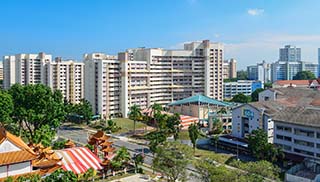
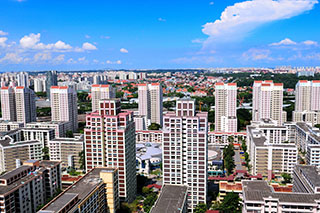
Bukit Batok iconic blocks along MRT line (built 1982-1989) / Hougang Central (built ~1989)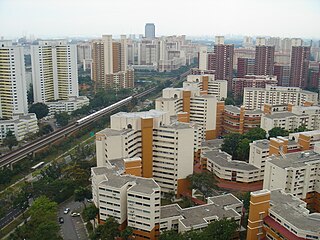
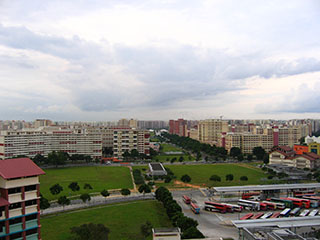
Bukit Panjang blocks 418, 419, 420 (built 1988) / Pasir Ris neighborhood 4xx (built 1989)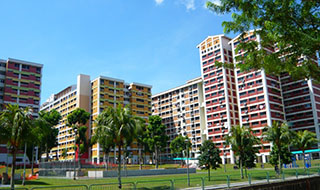
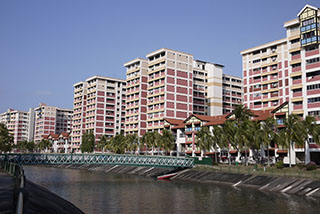
1980s typical HDB floor plans
Along the 3/4-Room New Generation and 5-Room Improved, in 1981 were introduced Model A flats: 3-Room (75 sqm), 4-Room (105 sqm), 5-Room (135 sqm), 5-Room Maisonette (139 sqm), and in 1984 were introduced Simplified flats, 3-Room (64 sqm), 4-Room (84 sqm).
Executive Apartment / Maisonette (146-150 sqm) were introduced in 1983 and replaced 5-Room Model A flats, in addition of the 3-bedroom and separate living/dining found in 5A flats, EA and EM feature an utility/maid room. 80% of Executive units were Maisonettes and 20% were Apartments. Some people misspell Mansionette.
New types of 4-Room Model A, 5-Room Improved, Executive Apartments / Maisonettes were introduced in 1987, the 5-Room and Executive having 4 bedrooms instead of 3 bedrooms (plus utility room in Executive), (source: Straits Times 1984).
Multi-Generation flats were 3/4-Room Simplified blocks reconfigured into 3-bedroom + Studio (granny flat), having 2 entrances and an internal door that join flats. The granny flat was not used as intended so the concept was abandoned after building only 8 blocks in 1987: Bishan 137, 148, Tampines 454, 460, Yishun 605, 632, 633, 666 (source: Straits Times 1986 + Straits Times 1988).
Rising popularity of bigger units left HDB with many unsold small flats. Last 1/2-Room Improved were in 1985 (Tampines 441, 442, 466, 471, all rental). Last 3-Room Improved and 3/4-Room New Generation were built in 1986. Last 3-Room Model A was built in 1987. Last 3/4-Room Simplified was built in 1988. Few blocks of 3/4-Room flats were converted into 5-Room and Executive flats, popularly called “Jumbo flats” (source: Straits Times 1989). Average HDB flat size for early 1980s estates is 90-100 square meters, and 120 sqm in 1991.
Despite that at least 10,000 dwelling units were completed each year, very few flats have leases 1990 and 1991. Number of flats with lease 1991 is about 6% of the number of flats with lease 1989 and 1992 according my analysis of resale transactions. A possible hypothesis is that HDB changed the purchase scheme and lease started later than actual completion date (can someone confirm?).
1981-1987 slab block with 3-Room Model A (73-75 sqm) and 4-Room Model A (105-108 sqm)
3½-Room Model A (88-90 sqm) exists but is so rare that I never found floorplan.
Website visitors reported that early 4-Room Model A have different floorplan, similar in shape with 4-Room New Generation with toilets near each other, but big as 105 sqm instead of 92 sqm.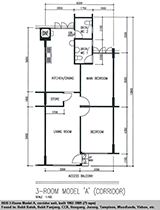
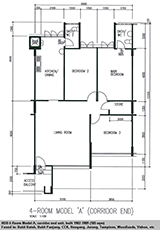
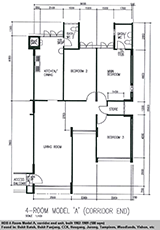
1981-1985 slab block with 4-Room Model A (104 sqm), 2 units per segment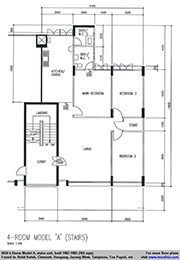
1981-1985 slab block with 5-Room Model A (133-135 sqm), 2 units per segment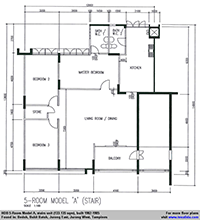
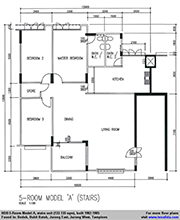
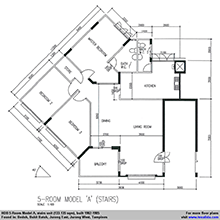
1984-1988 slab block with 3-Room Simplified (64 sqm), 4-Room Simplified (84 sqm) and 5-Room Improved (120 sqm)
A 4-room Model A lift-level version under 5-Room Improved should also exists.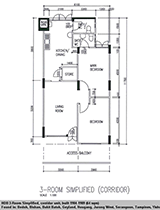
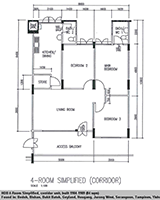
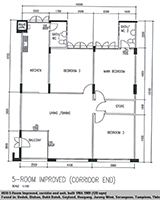
1984-1988 slab block with 4-Room Simplified (84 sqm) and 4-Room Model A (104 sqm)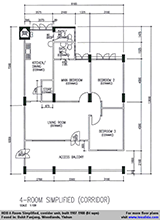
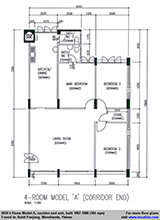
1982-1984 slab block with 5-Room Model A Maisonette (137-140 sqm, some -155 sqm) and 4-Room Model A (109 sqm) on corners (no floor plan found)
1983-1987 slab block with Executive Maisonette (144-147 sqm, some -160 sqm) and Executive Apartment (146 sqm) on corners
Many people asked me what is a 5-Room Maisonette or what is the difference compared with Executive Maisonette, the primary difference is the building year, because the two-storey Maisonettes were introduced earlier than Executive naming.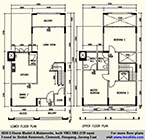
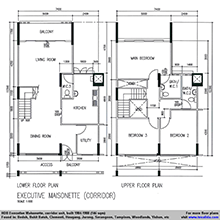
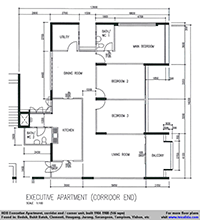
1987-1989 slab block with 4-Room Model A (104 sqm) and 5-Room Improved (121 sqm), some blocks have L-shaped corners, with 4-Room Model A (108 sqm) and 5-Room Improved (122 sqm)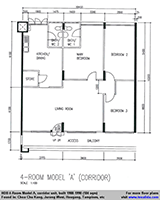
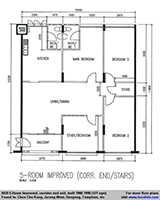
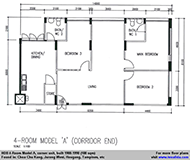
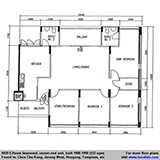
1988-1991 slab block with 4-Room Model A (103-107 sqm) and 5-Room Improved (121-123 sqm), 2 units per staircase.
Except corner units, all units are 4A, units at lift level are similar with 1987-1990 blocks, but units at next level up are 4A too instead of 5I, with a huge balcony, units at remaining levels have a small balcony facing over staircase void and big balcony of below units. Staircase landing is at middle of block, making lift upgrading unfeasible. Many such blocks did not got LUP.
First blocks with lifts stopping at every floor were announced in in Straits Times 1989 and was completed in 1992, featuring staggering corridors to offer privacy to at least 50% of units and direct lift access to at least 80% of units.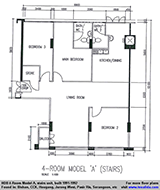
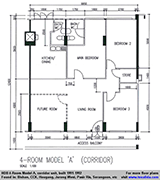
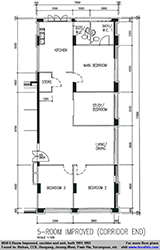

1987-1991 slab block with Executive Apartment (142 sqm) and Executive Maisonette (146 sqm)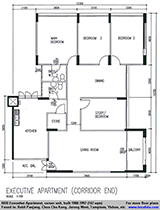
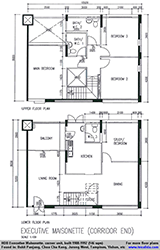
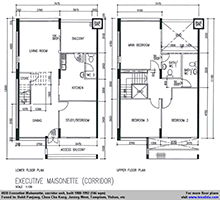
1987 slab block with Multi Generation flats (151-171 sqm)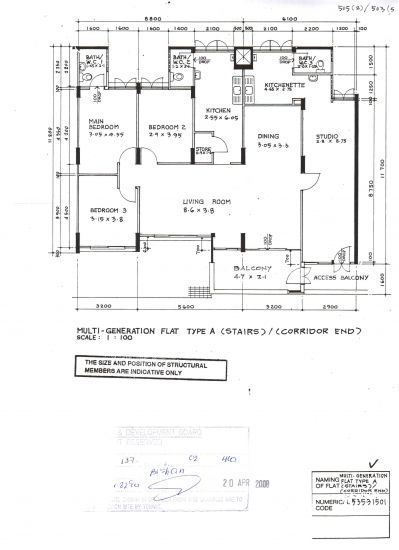
Jumbo and Adjoined HDB Flats
Some rental blocks were converted into bigger units, and sold with fresh leases from 1992 to 1996, unofficially called Jumbo Flat. They appear in HDB Resale Transactions as 4-Room Model A, 5-Room Improved / Model A, Executive Apartment and you cannot tell which of them are the jumbos.
Most Jumbo flats are in Woodlands and Yishun, few are in Tampines, Jurong East, and Ang Mo Kio (only smallest type from 2-room blocks). Their size vary from 90 sqm (2-Room + 2-Room) to 189 and 192 sqm (3-Room + 4-Room Model A), up to 7 rooms (5 bedrooms) and 3 toilets (source: Straits Times 1989). Unlike the 1980s Multi-Generation flats, Jumbos DO NOT have 2 entrances or 2 kitchens.
Since 1994 flat owners were allowed to buy an adjacent flat and adjoin them, but only for 3-room or smaller flats, officially called Adjoined Flat. They appear in HDB Resale Transactions as 4-Room / 5-Room / Executive Adjoined Flat. Adjoined flats CANNOT be 3-rm + 4-rm, can have 2 entrances but most owners walled one entrance.
Two examples of (Jumbo) Executive Apartment created from one 3-rm with one 4-rm, and one example of converting three 3-Room Simplified flats into two 4-rm flats.
images lost being deleted from the websites originally sourced from
Two examples of 5-Room Adjoined Flat composed by two 3-Room Improved or by two 3-Room New Generation (NOT a Jumbo flat)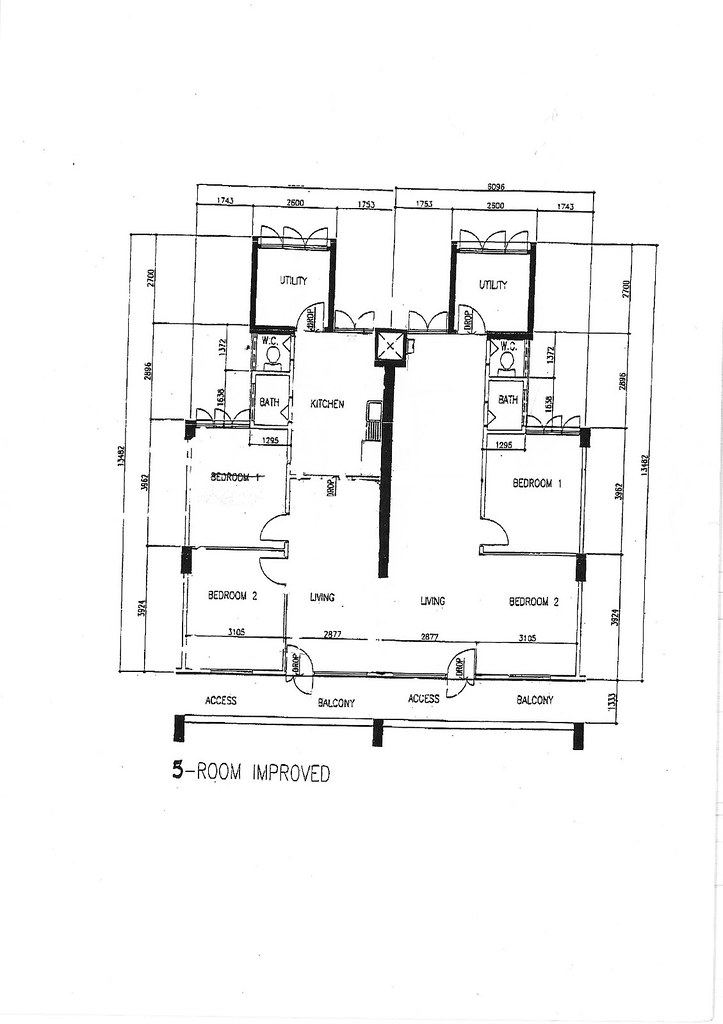
See more 1980s floor plans
1990s – The modern HDB blocks
In the early 1990s extensive construction was done in Choa Chu Kang, Hougang, Pasir Ris, Tampines, plus small additions in many other towns.
In the late 1990s three New Towns were started: Sembawang 1997, Sengkang 1997, Punggol 2000. Construction stopped for Tampines and Pasir Ris in 1995 (why?) but continued for Bukit Panjang, Choa Chu Kang, Hougang, Jurong East (Toh Guan Road), Jurong West (Pioneer area), Woodlands (Admiralty).
In mid-1990s majority of blocks range between 10-16 storeys, while blocks with household shelter built after 1998 range between 12-18 storeys, a small number of blocks have up to 30 storeys. Walk-up blocks almost disappeared. Unfortunately minimal distance between blocks was reduced to 18.3 metres (60 feet).
1990s was a decade of rapid development and innovation, raising the standard of living in public housing of Singapore to a level similar with private housing in other countries:
1992 – all blocks completed in 1992 have lifts stopping on every floor now and centralized refuse chutes (until 1993 some blocks have lift machine room at top floor so the flats at top floor do not have direct lift access).
1995 – introduction of yards for kitchens and by-panel main door.
1997 – introduction of household shelters and A/C ledges placed opposite of kitchen window, that double as second support for drying on bamboo poles.
2000 – first blocks competed in Punggol, a town built almost without corridor-facing flats (except 4 blocks and rental blocks built in 2010s) and green roofs on every MSCP.
2003 – last corridor-facing flats were completed (Sengkang blocks 207A-D).
1990s blocks are highly decorated and grouped in precints with distinctive styles, ground car parks were replaced by multi storey car parks, this allowed higher density, taller blocks, and more green space. All blocks are linked by covered walkways with car parks, bus stations and other facilities, so you can go anywhere regardless if the sun is too hot or is raining.
Since 1988 structural elements became thicker, 30 cm or more, rather than 20 cm in 1980s blocks, and more pillars per block. I do not know if this design is to withstand earthquakes.
Design & Build scheme was introduced in 1991, calling private architects to inject more variety into public housing designs (source), first project being at Tampines 230A-J (1992), featuring curved facades.
Design Plus followed in 1996.
Premium Apartments were introduced somewhere during 1990s, featuring better quality finishes, you get them in ready-to-move condition, with flooring, kitchen cabinets, built-in wardrobes? (compared with Standard Apartments where you get raw concrete waiting for your renovation).
Executive Condominium scheme was launched in 1995 (source: HDB Press Release 29 August 1995), subsidized private housing with facilities like private condos and same eligibility conditions like HDB (family nucleus, citizens and permanent residents, income ceiling). After 10 years since TOP date, all restrictions are lifted and even single foreigners can buy EC. See List of EC.
All premium contracts feature unique floor plan and corridor-facing flats are avoided. Since early 2000s standard contracts also became unique, putting the END to privacy issues of corridor-facing flats.
More and more land parcels were sold to private developers, making the percentage of population living in public housing to fall. Privatization of the former HUDC estates started in 1995 too.
The old HDB estates built in 1960s and 1970s suffered from dilapidated buildings, aging population and businesses moving out. On resale market Queenstown and Ang Mo Kio were cheaper than Pasir Ris, one of the cheapest towns today (source: analysis of Resale flat prices database). To prevent this, HDB launched Main Upgrading Programme in 1990 to improve pre-1980 estates, adding extra bathrooms for Standard flats, utility rooms, lifts that stop on every floor, redesigning facades for more modern look, building multi-storey car parks and converting surface car parks into green space, building covered walkways, etc. Interim Upgrading Programme was launched in 1993 for blocks built in 1980s, doing only small external upgrades.
Although small-scale redevelopment of old estates started in 1966, with demolition of single-storey artisans quarters, a massive demolition of 1-room HDB rental blocks occurred in 1988-1989 and continued into 1990s, it freed up land to build new blocks with 5-room and Executive units in mature estates like Bukit Merah, Queenstown and Toa Payoh. The HDB Floor Plans 1930-present is copyrighted by www.teoalida.com.
Selective En-bloc Redevelopment Scheme was announced in 1995 to demolish selected owner-occupied blocks built up to 1980 and rehouse the residents in new blocks built in nearby location, to maintain community. Usually low-rise blocks with large spaces between them are selected for SERS while dense and tall blocks are selected for upgrading. HDB do not give you a replacement flat automatically, they compensate you at market value, then you need to buy yourself a subsidized flat in replacement blocks which can be smaller or larger, and pay the difference with CPF. Since 2004 the residents can enjoy SERS benefits buying new flats anywhere instead of being limited to the designated replacement blocks. Redhill Close (built 1955) was the first upgraded blocks (MUP 1992) to be selected for SERS in 2011. See List of SERS sites.
HDB stopped deciding the prices of new apartments based on construction costs, instead they decided based on market prices. Prices of resale flats and new flats entered in a vicious circle, rising 50% in just 6 months of 1993 and tripled to 1996, then felt down 30% to 1998 and continued to fall in non-mature estates by 2006, while in mature towns they started rising in 2002, fueled by upgrading programmes and agents lying people that all old blocks will get SERS.
Pasir Ris blocks 601-615 (built 1993-1994)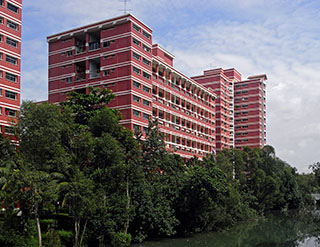
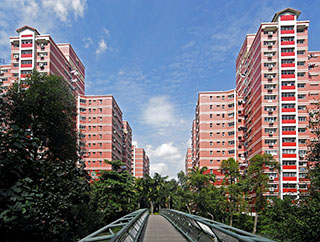
Bishan neighborhood 2xx famous for roofs in various heights (built 1990-1991) / Jurong East – Toh Guan Road precinct (built 1996-1998)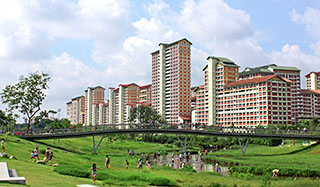
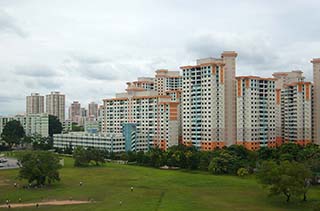
Bukit Panjang 5xx neighborhood (built 1996-1998)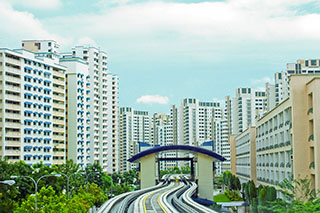
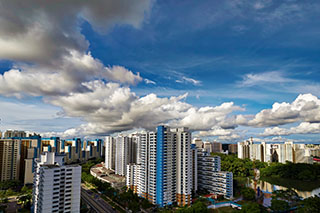
Early 1990s floor plans (centralized refuse chute era)
1990s HDB flats provide high variety of layouts in various sizes: 4-Room Model A (100-108 sqm), 5-Room Improved (120-128 sqm), 5-Room Model A (133-137 sqm), Executive Apartment / Maisonette (142-150 sqm). Share of 5-Room and Executive flats increased, raising average size of new flats to over 120 square meters in 1991-1996 (even 130 sqm in 1994-1995 due to Jumbo converted blocks).
An experiment with 2-Room flats was done in 1994 (Pasir Ris block 142), having 2-room units on ground floor and 4-room on rest of floors.
1991-1996 block with 4-Room Model A (107 sqm) and 5-Room Improved (125 sqm), 4/5-room corner units also exists!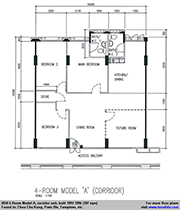
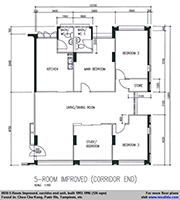
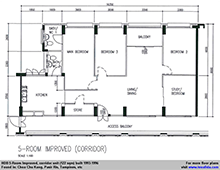
1994-1998 slab block with 4-Room Model A (100 sqm) and 5-Room Improved (120-123 sqm), some blocks have some smaller units named 4-Room Model A2 (90 sqm), some have different corners with 4-Room and 5-Room units, others have a wing with 2 units of 5-Room
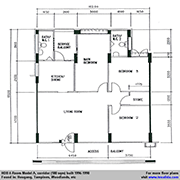
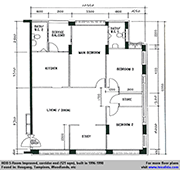
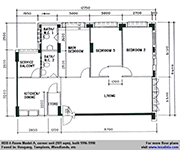
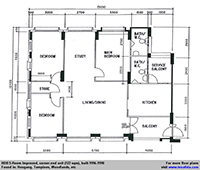
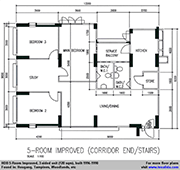
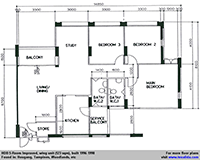
1991-1996 point block with Executive Apartment (144-147 sqm), some blocks are L-shaped with 4 units per floor (3 or 4 different layouts), or U-shaped with 5 units per floor, some are longer like slab blocks and include corridor units, some blocks are combined with Executive Maisonette
1994-1996 blocks provide service balcony for kitchen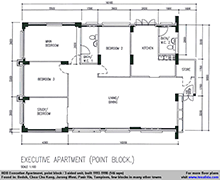
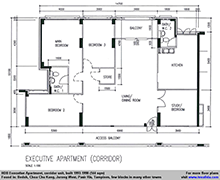
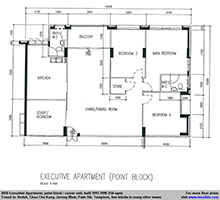
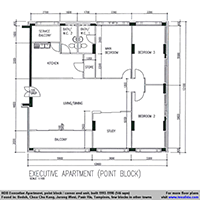
1991-1996 point block with Executive Apartment (146 sqm), 4 units per floor, two 146 sqm layout and other two different kitchen shape
1991-1996 atrium block with Executive Apartment (143-146 sqm), 6 units per floor, four 146 sqm layout and two 143 sqm layout
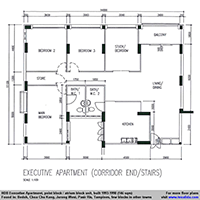
Late 1990s floor plans (household shelter era) – First downsize of HDB flats
Another revolution is visible for the HDB flats completed since 1997: Block naming system (slab, point, atrium) has been abandoned. Flat naming system (Improved, Model A, etc) is no longer used in sale brochures, where a new naming system was introduced: Type A = 4-rm, Type B = 5-rm, Type C = Executive and the word Flat was replaced by Apartment. Resale transactions still show old flat type naming, and after 1998 all 4-rm are Model A and all 5-rm are Improved.
The flat sizes were standardized, slightly smaller: 4-Room (100 sqm), 5-Room (120 sqm), Executive (140 sqm). Percentage of EM was reduced compared with EA because of aging population who do not like stairs (source: Straits Times 1989) and the last maisonette was completed in 2000.
The 5-Room lost the study area, being just a 3-bedroom flat with larger living room. Executives are 3 bedrooms plus open study area that can be walled into a 4th bedroom. Average flat size 110 sqm.
A household shelter was provided in every flat, a store room with strengthened 30 cm walls and sealing door. Useless feature in my opinion, the shelter eats about 5 sqm, sometimes placed in middle of flat, hacking it is not allowed making floor plan less flexible (some exceptions in 2000s: all 1/2-rm rental blocks and some 2/3-rm sold blocks have a common storey shelter instead of household shelter inside flat).
1997-1999 block with 4-Room Model A (100 sqm), 5-Room Improved (120 sqm) and Executive Apartment (140 sqm), some blocks have 4-Room Model A2 (90 sqm)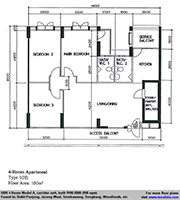
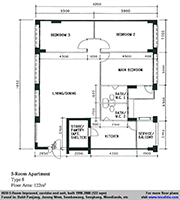
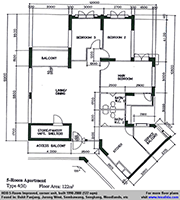
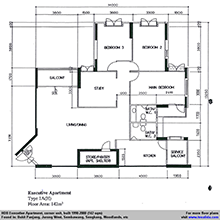
1997-1998 block with Executive Apartment (140 sqm) and Executive Maisonette (142 sqm).
Executive Maisonette with bomb shelter RARE, only 10 blocks!! (no floorplan found for EA pair)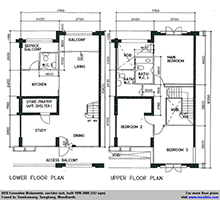
Second downsize of HDB flats
All HDB flats completed since 2000 lost 10 sqm, their sizes being 4-Room (90 sqm), 5-Room (110 sqm), Executive (130 sqm, 125 sqm after 2003).
In attempt to reduce number of corridor-facing flats, the shape of blocks became complex, with many corners where 5-Room units are located. In 2002 and 2003 the number of 5-Room flats exceeded 4-Room, so the average flat size remained high as 105 sqm in 2000-2005.
1999-2003 block with 4-Room Model A (90 sqm), 5-Room Improved (110 sqm) and Executive Apartment (130 sqm in 1999-2001, 125 sqm in 2002-2003)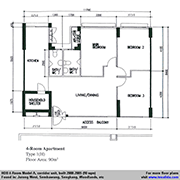
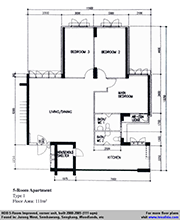
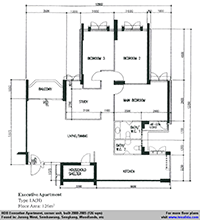
See more 1990s floor plans
2000s – The decline
During 2000s, no other New Town or Estate were started. Construction continue only in existing estates. Taller and taller blocks were built in all estates not too close to airports to have height constraints. 30-storey complexes appeared since late 1990s, and the first 40-storey complex (Toa Payoh Towers) was completed in early 2005 (source).
The demand for new flats felt sharply after 1997 Asian Crisis. 2003 SARS outbreak and low immigration rate in early 2000s also slowed down the demand for flats. This happened right after the most prosperous decade, with 24,000-36,000 flats completed each year between 1994 and 2001. The queue, once 5 years long, vanished and left about 40,000 unsold completed flats in the year 2000, most of them being 5-Room and Executive.
HDB made a surprise decision in 1995 to close the registration queue for Executive flats, shortly after introduction of Executive Condominiums. Last EM was completed in 1998 and last EA in 2003, for people in the queue. Supply of 5-Room flats was also reduced and very few were completed in 2007-2009. A common misconception is that Executive Apartments were replaced by Executive Condos. Wrong, Executive Condos include flats in variety of sizes from 50 to 300+ sqm.
The Registration for Flat (queue selling system) was suspended in 2002 due to unsold flats.
Walk In Selection has been introduced in March 2002 allowing people to book unsold flats anytime. It ended in February 2007 and was replaced by balloting exercises named Quarter-Yearly Sale of 2/3-Room flats and Half-Yearly Sale of 4-Room and bigger flats, which in 2010 were combined in Sale of Balance Flats, which sell leftover flats from past BTO and SERS projects, plus old flats repurchased by HDB. Because some flats are completed and you can collect keys immediately after balloting, so many people apply for SBF and in towns with low number of flats 100+ people battle for one flat.
Build-To-Order was introduced in April 2001 to became main supply of HDB flats. Flats are offered for sale before being built. Tender for construction is called only if at least 70% of units have been booked (50% since 2011). See list of BTO launches.
Design, Build and Sell Scheme is public housing built by private developers and sold by agents, their architectural design is similar with condos, but lack condo facilities such as guards, gym, pool, tennis courts, etc. First DBSS project was launched in 2006 and completed in 2009. DBSS land sales were suspended in July 2011 after the Sim Lian Group, developer of Centrale 8 (8th DBSS) set outrageous prices up to $880,000 for 5-Room. 13 land parcels were sold to private developers who built 8650 DBSS apartments. See list of DBSS projects.
Punggol 21, a modern waterfront town featuring a mix of high-end HDB and Executive Condos, was announced in 1996 and got first residents in 2000 or 2001. It is the first HDB town where each precint is individually designed and feature integrated carparks with green roofs, and no corridor-facing units. 1997 Asian Crisis and 2003 SARS turned Punggol into a ghost town with many unsold flats and no amenities. It had 3768 4-Room, 10031 5-Room, 1126 Executive units as 31 March 2004, construction almost halted until 2010. The Punggol LRT Line, despite having both loops completed in 2004, east loop opened in 2005 while the west loop opened only in 2014.
Punggol 21+ was announced in 2007 to rejuvenate the town, involving building a waterway through undeveloped part of town, amenities and low-end BTO projects with 2/3/4-room units. Imagine that if there was no 1997 Asian Crisis, Punggol was developed with big flats but without waterway!
Sembawang Blue Riverview (built 1999-2000) and Sengkang Compassvale South Gate (built 1999)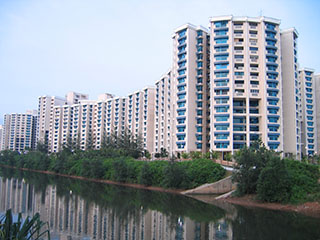
Punggol blocks 178-193, last batch of Executive Apartments (built 2002-2003) and Eastdale blocks 637-652 (built 2003)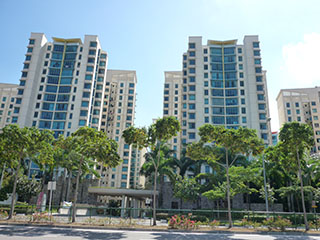
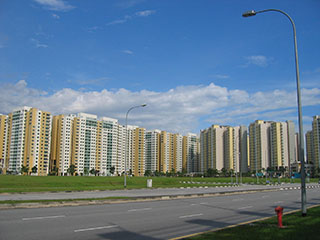
Punggol – Edgedale Green (built 2006-2007) and Periwinkle (built 2005-2006)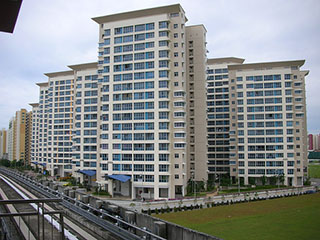
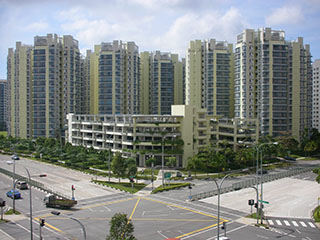
Commonwealth View (built 2007) and The River Vista @ Kallang (built 2010)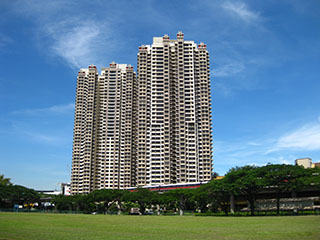
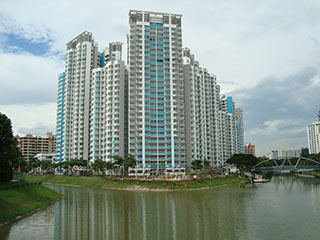
2000s random HDB floor plans
Along 4-Room (90 sqm) and 5-Room (110 sqm), HDB reintroduced 3-Room (60 sqm, later 65 sqm) and 2-Room (35/45 sqm).
HDB announced in 1998 that will resume building 3-room flats on ad-hoc basis (source). The first were in Cantonment Towers (SERS replacement block completed in 2000, lease 2002) and Clementi 366-367 (blocks with 1/2/3-Room flats completed in 2001, lease 2003). Special mention to Yishun 849 (weird block with completion year 2002 and lease date 01 Jul 1999 according HDB Centralized Map).
3-Room was introduced in BTO as mainstream supply in Fernvale Grove (launched August 2004, completed in 2007-2008), 2-Room was introduced in Fernvale Vista (launched July 2006, completed in 2010).
Studio Apartments (35/45 sqm) were introduced in 1998 (first 6 Studio blocks were completed in 2001), they are restricted to elderly (55+ years old), 30-year leases and cannot be sold in resale market. Originally were built in all-studio blocks, but in 2005 Eunos Court was completed with Studio mixed with normal flats.
The average size of new flats dropped from 105 sqm in 2000-2005 to 90 sqm in 2007 and around 80 sqm later.
HDB resumed building rental blocks in 2007, completing in 2009 first new corridor-style blocks with 1/2-room apartments, for people who are unable to own a flat.
2000s projects feature unique designs, although similar circular pattern: living – common bedrooms – master bedroom – bathrooms – kitchen, but with a lot of variations in room sizes and windows, there are variations even from one floor to another floor of same block, so I cannot post on my website all possible floor plans.
2000s flats offer full privacy (except rental blocks). Flats with rooms facing to corridor were built in small numbers until 2004 lease year. First BTO project was completed in 2004 and got lease from 2006, so all BTOs offer full privacy. Compared with 1990s flats, the layouts were improved, bedrooms were downsized in favor of larger living room, the study area returned in 5-room flats, and common toilet entrance is no longer in kitchen.
Typical floor from 2000s: Studio (35 / 45 sqm), 3-Room (65 sqm), 4-room (90 sqm), from Eunos Court and Kallang Heights SERS projects. BTO projects use similar layouts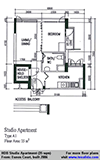
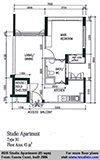
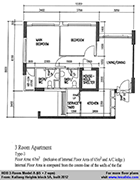
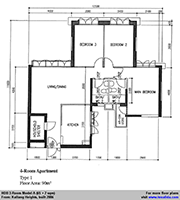
2003-2004 Punggol floor plans: 5-Room (114 sqm) and Executive (128 sqm), oversized living room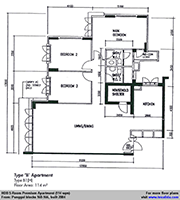
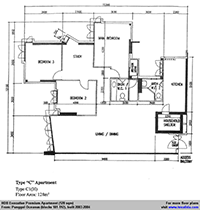
Pinnacle @ Duxton, the first 50-storey public housing complex, was launched via BTO in May 2004 and got first residents in December 2009, for HDB anniversary of 50 years in February 2010. Composed by 7 blocks × 44 residential floors × 6 units per floor = 1848 units, it was the biggest BTO project to date. It included 2 levels of skybridges, 2 flat types (S1 4-Room 90-93 sqm and S2 5-room 103-106 sqm), different combinations of bay windows, balconies and planters create 35 distinct flat layouts.
See more 2000s floor plans
2010s – Today trends
Three new housing areas were announced in HDB Press Release in 2013: Bidadari Estate (within Toa Payoh planning area), Tampines North and Punggol Matilda. The planning work for Bidadari started in 2012 and got first BTO launches in 2015. Other areas with massive construction (not officially announced) were Bukit Batok (west end), Choa Chu Kang (south end), Yishun (east side), Sembawang (south area towards Yishun).
Timothy wrote in 2011 on Wikipedia that after the current New Towns will be saturated, HDB will start building flats in Tengah, Simpang, Bukit Brown, Bidadari and Seletar… looks like a personal guess rather than official info.
Tengah, the 24th New Town, was officially announced in 2016 and first BTO was launched in Nov 2018.
HDB prices stabilized between 2015 and 2020. When COVID-19 pandemic started, I was expecting prices dropping like during 2003 SARS, but contrary happened: internet connection available nowadays allowed people to work from home, and despite that pandemic caused a short-term global recession, it changed people lifestyle towards investing more in (bigger) homes, further accelerating prices growth, especially for outer towns.
2010s flats
SkyVille & SkyTerrace @ Dawson, two iconic BTO projects broke record of most expensive HDB flats, due to prime location near Queenstown MRT, and were still oversubscribed (9865 applications for all 1718 units, up to 12 applicants for each 5-rm unit, but in case of 3-rm units were slightly less applicants than units). Flats are even smaller than in Pinnacle@Duxton, to 83 sqm for 4-rm and 101 sqm for 5-rm. SkyTerrace feature lofts and paired units (similar with dual-key units in condos), caused waste of space in already too small apartments.
Other BTO projects of 2010s decade remained at the standard sizes 45 / 65 / 90 / 110 sqm (internal floor area, in resale transactions they will appear 2-6 sqm bigger due to A/C ledge and balcony). Supply of 5-room was increased, average flat size rose from 80 sqm for BTO flats launched in 2009 to 85 sqm in 2012, then dropped to 75 sqm in 2014 due to increased supply of 2-room flats once singles over 35 were allowed to purchase new HDB 2-room flats.
Meantime, private developers downsized apartments, affecting DBSS and EC projects too, for example Trivelis sizes are 60 / 80-82 / 105 sqm. Of the 105 sqm 5-room, only 88 sqm is internal, be shocked at floor plan! If they specify balcony size 12 sqm, living room should be 3×5 m, common bedrooms 3×2.5 m, study 2x2m.
HDB do not reintroduce Executive Apartments, motivating that these flats were purchased by rich families who can afford too much space for no reason, also the average household size dropped thus larger flats are no longer necessary. Instead, HDB introduced 3gen flats in July 2013 BTO and restricted them to a married couple plus another family relative. 3gen flats have 4 bedrooms and 3 bathrooms in 115 sqm (following a trend started by Executive Condominiums that introduced 5-bedroom flats).
2-Room Flexi was announced on 19 August 2015, they replace Studio Apartments and 2-Room, can be purchased both by elderly (15-45 years lease, no resale market) and by families and singles (99 years leases, can be sold on resale market).
Skyville @ Dawson, smallest 4-Room BTO flat (83 sqm) / new 3gen flat introduced in 2013
2020s – Today trends
To keep flats affordable in Central Region and reduce profit that owners will make at reselling, several schemes were proposed during 2010s, including introducing flats with shorter lease.
In 2021 HDB introduced Prime Location Housing, with minimum occupation period of 10 years instead of 5 years, no subletting whole flat, and must pay 6% clawback upon resale.
The success with PLH scheme determined HDB to reclassify new flats launched since 2024 as Standard, Plus, Prime. Details like MOP for each flat type are yet to be announced.
More USEFUL info
How to find the age of a HDB block
HDB do not provide exact year of construction, except in press release about the blocks that are selected for SERS.
HDB provide instead the Lease commence date in Resale Flat Prices e-service for blocks available on resale market (no blocks under MOP or rental blocks). In Singapore the lease commence date is more important than building year. Lease year correspond with building year + 1, with few exceptions.
See also Enquire status of HDB upgrading programmes e-service, showing number of units in any block, too bad that they do not display the year of construction, as selection for upgrading programmes is based on construction year.
How urban planning in Singapore was done
Since 1960 to 1990s all HDB towns were planned using a standard density of 200 dwelling units per hectare. Flat sizes were growing over the years, leading to a stupid situation: the blocks with big flats and wealthy residents were denser and their occupants did not had enough space to park their cars, while the 1-room rental flats had largest open spaces and empty carparks.
Somewhere in 1990s a new urban planning control was introduced: plot ratios (gross floor area divided by land area). To create a vibrant city, low-, medium and high-density areas were created. The ratios were revised and raised in Master Plan 1998, today most public housing are in 2.8 – 4.2 range, low-density condos are low as 1.4 while office buildings in Central Business District reach a plot ratio of 12.
How many New Towns built HDB in Singapore
Based on construction stages:
- Singapore Improvement Trust (SIT) and Housing and Development Board (HDB) built 20 New Towns (10,000-70,000 units) and about 80-100 small estates (under 10,000 units).
- Economic Development Board (EDB) built in 1964-1968 and Jurong Town Corporation (JTC) built between 1968 and late 1970s 5 estates in Jurong and Sembawang industrial areas.
- Housing and Urban Development Company (HUDC) built between 1974 and 1987 22 estates totaling about 9,800 units, sandwich housing for middle-income people who did not qualify for HDB flats but could not afford a private property. List of HUDC estates.
HDB took over JTC and HUDC in 1982, becoming sole provider of public housing in Singapore. The last 12 HUDC estates were actually built by HDB.
The HDB Annual Reports up to 1989 display a list of about 100 estates.
Based on current town boundaries:
URA defined 55 Planning Areas in 1991, HDB New Towns and Estates were reorganized into 20 “Towns” and 11 “Other Estates” in AR 1990, few years later the other estates were regrouped into 6, of which Sembawang and Sengkang were turned into “towns” in AR 1996, Punggol was added in AR 1999, Lim Chu Kang was demolished, leaving 23 towns and 3 estates, figure unchanged for almost 20 years. Tengah was announced in 2016 as 24th HDB Town. There is no relation between Planning Areas / Towns and historical development HDB New Towns / Estates.
The current 24 HDB Towns and 3 Estates match URA planning areas with 2 exceptions:
- Kallang-Whampoa is one HDB town stretching on 3 planning areas (Kallang, Whampoa, Novena).
- Pasir Ris town also include Changi Village (from Changi planning area).
More notes:
- Geylang, Kallang-Whampoa and Bukit Merah towns contains several HDB estates built inside original Singapore city so are not “new towns” but Annual Report classify them as “town”.
- Central Area, Bukit Timah and Marine Parade appear in Annual Report under “other estates” and in HDB Resale Flat Prices e-service as “town”.
- Lim Chu Kang estate is no longer in use since 2001, but it appeared in HDB Resale Flat Prices e-service until 2009.
- Tengah was added in HDB Resale Flat Prices e-service in 2016, despite that first BTO was launched in November 2018 and only around 2026 the flats are expected to reach resale market.
About me
I wrote this article from my personal research since 2009, because others (including Wikipedia) were incomplete, not enough detailed, create confusion and may contain errors. Please do not copy any part of page TEXT without my approval. Photographs are from Wikipedia, Panoramio, etc. Feel free to use the HDB floor plans but keep bar at bottom that indicate my website URL, for using photographs you may want to ask permission to their original authors.
I can identify flat types in 99% of HDB blocks just by looking in satellite photos, eventually Google street view, and indicate you approximate floor plans but I cannot guarantee 100% matching. I can also help you if you have a floor plan and want to know in which blocks can be found, thanks to my high experience in architecture.
In the past I helped numerous people, but as website traffic increased, it became annoying to answer each one. Since 2010 I compiled the Database of HDB blocks for purpose of selling data in Excel format to business use, and since 2017 I allow anyone to query database for free on Interactive map of HDB blocks (clicking 1 block at time to view possible floor plans), but you can also search by floor plan and see all blocks having same layout.
Numerous people message me asking for / attempted to pay me to buy an exact floor plan of a specific unit number from specific block. You can purchase HDB floor plans for 5 dollars on HDB InfoWeb, NOT on my website.
How I got floor plans?
During initial research in 2009, I picked 52 floor plans from October 2009 Sale of Balance Flats, copying images from PDF brochures (one PDF per town, few hundred floor plans to choose from). They had cream background, about 400-600 pixels tall, 29 pixels per meter. Additional floor plans I collected from random forums and blogs, reaching 100 floor plans in 2012 that represent 90% of all HDB flat types built before BTO era. Images were resized with HTML code “height=200px” so anyone accessing the page, had to download 20 MB of full-size images, causing excessive server load.
In 2014, to reduce bandwidth usage and improve website design, I re-made the floor plans using March 2012 Sale of Balance Flats (individual PDF for each flat). I screenshot PDF file at 100% zoom, cropped image in Paint then added the gray info bar at bottom. Full-size images about 600-1000 pixels tall (44 pixels per meter), and thumbnail images at 1/4 size. Page weight reduced to 8 MB. See comparison: OLD vs NEW floor plans.
You can find floor plans using Google Images, search by BTO name or street name (don’t search by block number because most people don’t indicate exact block). Most floor plans are posted by people selling flats or asking for renovation ideas. Due to this reason is hard to find floor plans for under construction blocks.
I downloaded over 10,000 files from Sale of Balance Flats between 2008 and 2016 (I spent 15-20 hours to download all files from each sale): individual flat plans in PDF (dimensions and unit number indicated in file name), whole block plans in PDF (no dimensions), site plans in JPG, etc. I can provide my collection for a price. It is NOT a complete collection of all HDB flats ever built, it contains ONLY flats offered for sale at Sale of Balance Flats, including many identical / duplicate floor plans.
The floor plans collection is far away from being “complete”
This page was intended as educational material, showing HDB history and evolution of typical floor plans, but the audience is mostly resale flat buyers than students, they believe that this is / they want this to be a complete collection HDB floor plans, no matter how many floor plans I post, they want more!
Numerous people attempted to contribute / complete my collection by sending me their own floor plans (in most cases, too similar with one posted already, or too rare to worth posting), other people complain that the website is cluttered. This is why I decided in late 2012 to STOP HDB floor plans page at ~100 floor plans. In 2016 I created a second page HDB floor plans (rare layouts) for what I received from contributors. See statistics: most downloaded HDB floor plans, I may delete images with low number of clicks to improve usefulness of website.
Currently I post floor plans from contributors only on Interactive map of HDB blocks (for people clicking the block from which they belong), not visible on website itself. If a block does not show floor plans, DON’T message me asking for floor plans, most likely I never found / nobody sent me any floor plan from that block.
Too many floor plan variations
Until early 2000s, HDB used similar designs all over Singapore, while some towns feature distinctive façade design since 1980s, the floor plan is nearly same, but minor variations exists. For example: 3-Room New Generation flat (67 sqm), the 20cm thick wall is only for unit next to staircase, other units have 10cm thick wall, units that are next to corridor-end unit display on floor plan the door of neighbor unit, these 4 floor plans can be mirrored, total 8 possible floor plans.
Since introduction of BTO scheme in 2001, each project is uniquely designed, nearly 400 BTO projects been launched as 2022, with a total of over 1100 flat types (from studio to 5-room and 3gen). Layout vary from a stack to another, sometimes windows and balcony vary between floors, resulting in few thousands different floor plans. I will never be able to collect al, even colleting 50% require too much effort considering that I don’t get paid by doing this.
If you are student or love architecture, see also my own apartments designs, some being inspired from HDB designs and improved or alternatives to HDB layouts.
Other articles about history of public housing in Singapore
http://www.nas.gov.sg /1stcab/7585/travel_exh_Sec6.html
http://remembersingapore.wordpress.com > from-villages-to-flats-part-2
http://morrischia.com/david/portfolio/boozy/research/ hdb_20flats_20analysis.html
http://www.globalurban.org /GUDMag07Vol3Iss1/Yuen.htm
Visit Hometrust to read Singapore interior designer reviews.


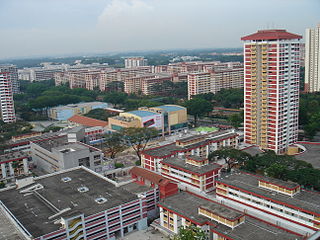
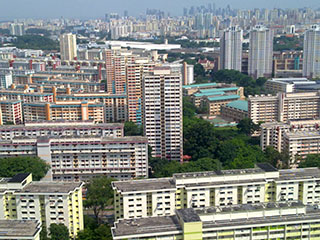
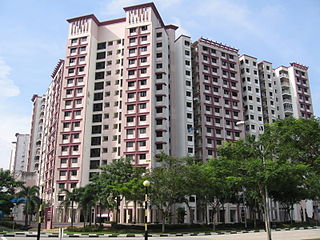
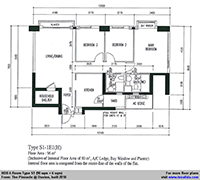
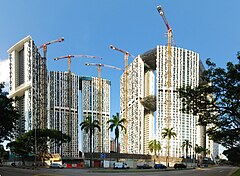
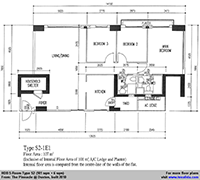

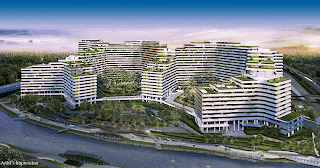 a
a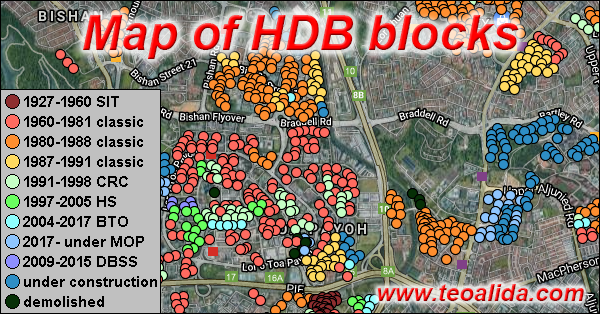
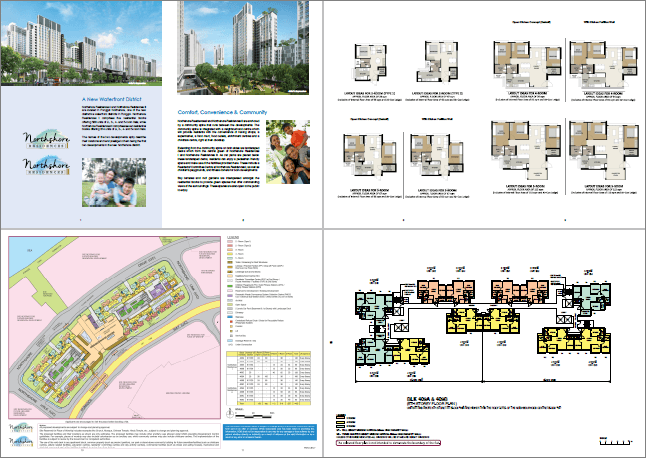
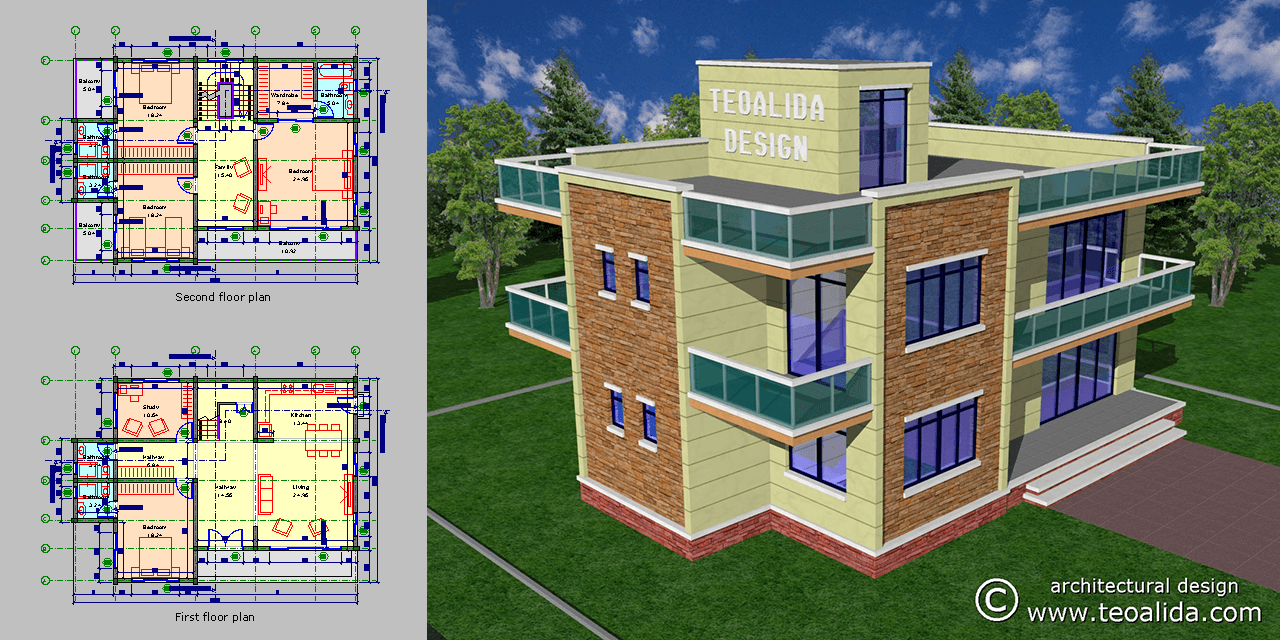
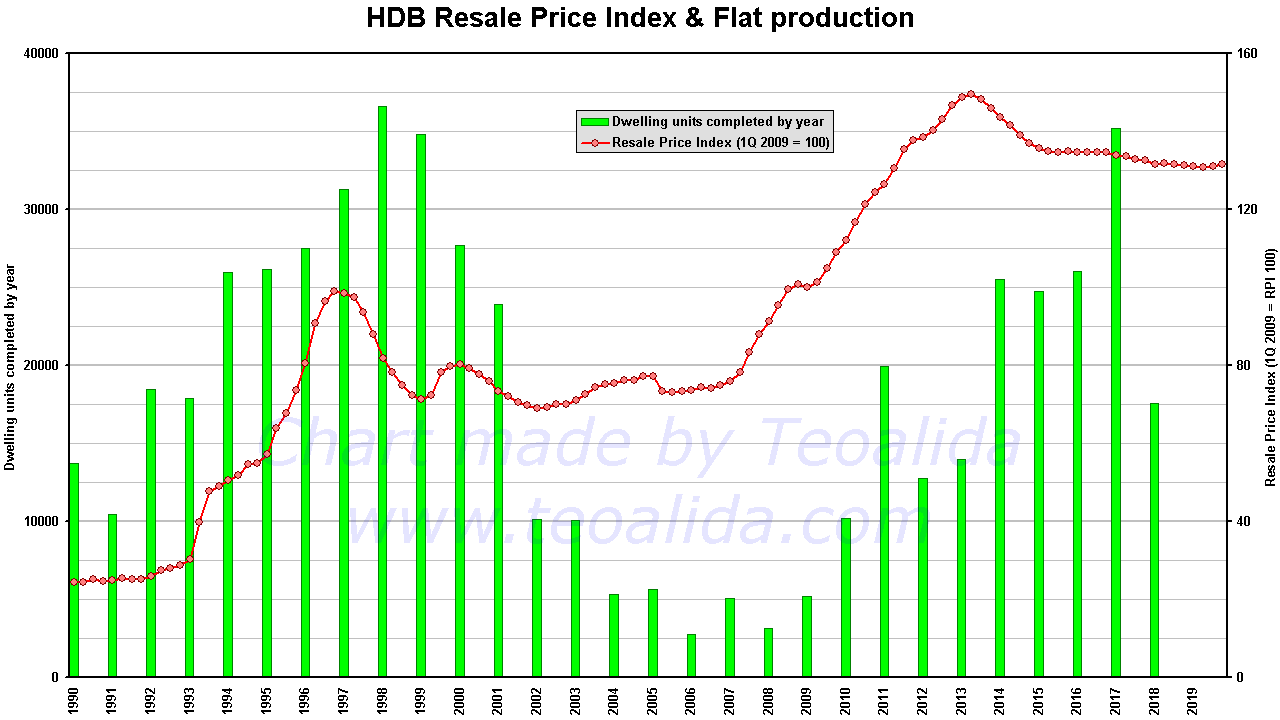
Thank you for providing this information. I am delighted to come on this fantastic article.
Thank you for creating such an extraordinary piece of content. It has not only entertained me but also inspired me greatly.
I’m grateful for the insightful content you’ve shared.